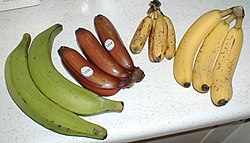Template:Transclude random excerpt/testcases
| This is the template test cases page for the sandbox of Template:Transclude random excerpt. to update the examples. If there are many examples of a complicated template, later ones may break due to limits in MediaWiki; see the HTML comment "NewPP limit report" in the rendered page. You can also use Special:ExpandTemplates to examine the results of template uses. You can test how this page looks in the different skins and parsers with these links: |
Random cricket article from list
[edit]If it's always Cricket bat, be suspicious!
| {{Transclude random excerpt}} | {{Transclude random excerpt/sandbox}} |
|---|---|
 Bodyline, also known as fast leg theory bowling, was a cricketing tactic devised by the English cricket team for their 1932–33 Ashes tour of Australia. It was designed to combat the extraordinary batting skill of Australia's leading batsman, Don Bradman. A bodyline delivery was one in which the cricket ball was bowled at pace, aimed at the body of the batsman in the expectation that when he defended himself with his bat, a resulting deflection could be caught by one of several fielders deliberately placed nearby on the leg side. At the time, no helmets or other upper-body protective gear was worn, and critics of the tactic considered it intimidating, and physically threatening in a game traditionally supposed to uphold conventions of sportsmanship. The England team's use of the tactic was perceived by some, both in Australia and England, as overly aggressive or even unfair. It caused a controversy that rose to such a level that it threatened diplomatic relations between the two countries before the situation was calmed. Although no serious injuries arose from any short-pitched deliveries while a leg theory field was set, the tactic led to considerable ill feeling between the two teams, particularly when Australian batsmen were struck, inflaming spectators. After the introduction of helmets, short-pitched fast bowling, sometimes exceeding 90 miles per hour (140 km/h), continues to be permitted in cricket, even when aimed at the batsman, and is considered to be a legitimate bowling tactic when used sparingly. Over time, several Laws of Cricket were changed to render the bodyline tactic less effective—and increase player safety—such as a legside field restriction, concussion breaks and inspections. (Full article...) |
 Bodyline, also known as fast leg theory bowling, was a cricketing tactic devised by the English cricket team for their 1932–33 Ashes tour of Australia. It was designed to combat the extraordinary batting skill of Australia's leading batsman, Don Bradman. A bodyline delivery was one in which the cricket ball was bowled at pace, aimed at the body of the batsman in the expectation that when he defended himself with his bat, a resulting deflection could be caught by one of several fielders deliberately placed nearby on the leg side. At the time, no helmets or other upper-body protective gear was worn, and critics of the tactic considered it intimidating, and physically threatening in a game traditionally supposed to uphold conventions of sportsmanship. The England team's use of the tactic was perceived by some, both in Australia and England, as overly aggressive or even unfair. It caused a controversy that rose to such a level that it threatened diplomatic relations between the two countries before the situation was calmed. Although no serious injuries arose from any short-pitched deliveries while a leg theory field was set, the tactic led to considerable ill feeling between the two teams, particularly when Australian batsmen were struck, inflaming spectators. After the introduction of helmets, short-pitched fast bowling, sometimes exceeding 90 miles per hour (140 km/h), continues to be permitted in cricket, even when aimed at the batsman, and is considered to be a legitimate bowling tactic when used sparingly. Over time, several Laws of Cricket were changed to render the bodyline tactic less effective—and increase player safety—such as a legside field restriction, concussion breaks and inspections. (Full article...) |
Random article from a list that's mainly rubbish
[edit]Should always be Cat or Dog
| {{Transclude random excerpt}} | {{Transclude random excerpt/sandbox}} |
|---|---|
|
The dog (Canis familiaris or Canis lupus familiaris) is a domesticated descendant of the wolf. Also called the domestic dog, it was selectively bred from an extinct population of wolves during the Late Pleistocene by hunter-gatherers. The dog was the first species to be domesticated by humans, over 14,000 years ago and before the development of agriculture. Experts estimate that due to their long association with humans, dogs have gained the ability to thrive on a starch-rich diet that would be inadequate for other canids. Dogs have been bred for desired behaviors, sensory capabilities, and physical attributes. Dog breeds vary widely in shape, size, and color. They have the same number of bones (with the exception of the tail), powerful jaws that house around 42 teeth, and well-developed senses of smell, hearing, and sight. Compared to humans, dogs have an inferior visual acuity, a superior sense of smell, and a relatively large olfactory cortex. They perform many roles for humans, such as hunting, herding, pulling loads, protection, companionship, therapy, aiding disabled people, and assisting police and the military. Communication in dogs includes eye gaze, facial expression, vocalization, body posture (including movements of bodies and limbs), and gustatory communication (scents, pheromones, and taste). They mark their territories by urinating on them, which is more likely when entering a new environment. Over the millennia, dogs became uniquely adapted to human behavior; this adaptation includes being able to understand and communicate with humans. As such, the human–canine bond has been a topic of frequent study, and dogs' influence on human society has given them the sobriquet of "man's best friend". The global dog population is estimated at 700 million to 1 billion, distributed around the world. The dog is the most popular pet in the United States, present in 34–40% of households. In developed countries, around 20% of dogs are kept as pets, while 75% of the population in developing countries largely consists of feral and community dogs. (Full article...) |
The dog (Canis familiaris or Canis lupus familiaris) is a domesticated descendant of the wolf. Also called the domestic dog, it was selectively bred from an extinct population of wolves during the Late Pleistocene by hunter-gatherers. The dog was the first species to be domesticated by humans, over 14,000 years ago and before the development of agriculture. Experts estimate that due to their long association with humans, dogs have gained the ability to thrive on a starch-rich diet that would be inadequate for other canids. Dogs have been bred for desired behaviors, sensory capabilities, and physical attributes. Dog breeds vary widely in shape, size, and color. They have the same number of bones (with the exception of the tail), powerful jaws that house around 42 teeth, and well-developed senses of smell, hearing, and sight. Compared to humans, dogs have an inferior visual acuity, a superior sense of smell, and a relatively large olfactory cortex. They perform many roles for humans, such as hunting, herding, pulling loads, protection, companionship, therapy, aiding disabled people, and assisting police and the military. Communication in dogs includes eye gaze, facial expression, vocalization, body posture (including movements of bodies and limbs), and gustatory communication (scents, pheromones, and taste). They mark their territories by urinating on them, which is more likely when entering a new environment. Over the millennia, dogs became uniquely adapted to human behavior; this adaptation includes being able to understand and communicate with humans. As such, the human–canine bond has been a topic of frequent study, and dogs' influence on human society has given them the sobriquet of "man's best friend". The global dog population is estimated at 700 million to 1 billion, distributed around the world. The dog is the most popular pet in the United States, present in 34–40% of households. In developed countries, around 20% of dogs are kept as pets, while 75% of the population in developing countries largely consists of feral and community dogs. (Full article...) |
Random article from a list that's totally rubbish
[edit]Error: no valid article
| {{Transclude random excerpt}} | {{Transclude random excerpt/sandbox}} |
|---|---|
|
Excerpt error: No valid pages found |
Excerpt error: No valid pages found |
All articles
[edit]| {{Transclude random excerpt}} | {{Transclude random excerpt/sandbox}} |
|---|---|
|
A banana is an elongated, edible fruit – botanically a berry – produced by several kinds of large treelike herbaceous flowering plants in the genus Musa. In some countries, cooking bananas are called plantains, distinguishing them from dessert bananas. The fruit is variable in size, color and firmness, but is usually elongated and curved, with soft flesh rich in starch covered with a peel, which may have a variety of colors when ripe. It grows upward in clusters near the top of the plant. Almost all modern edible seedless (parthenocarp) cultivated bananas come from two wild species – Musa acuminata and Musa balbisiana, or hybrids of them. (Full article...) An apple is a round, edible fruit produced by an apple tree (Malus spp., among them the domestic or orchard apple; Malus domestica). Apple trees are cultivated worldwide and are the most widely grown species in the genus Malus. The tree originated in Central Asia, where its wild ancestor, Malus sieversii, is still found. Apples have been grown for thousands of years in Eurasia and were introduced to North America by European colonists. Apples have religious and mythological significance in many cultures, including Norse, Greek, and European Christian tradition. (Full article...)  |
 An apple is a round, edible fruit produced by an apple tree (Malus spp., among them the domestic or orchard apple; Malus domestica). Apple trees are cultivated worldwide and are the most widely grown species in the genus Malus. The tree originated in Central Asia, where its wild ancestor, Malus sieversii, is still found. Apples have been grown for thousands of years in Eurasia and were introduced to North America by European colonists. Apples have religious and mythological significance in many cultures, including Norse, Greek, and European Christian tradition. (Full article...) A banana is an elongated, edible fruit – botanically a berry – produced by several kinds of large treelike herbaceous flowering plants in the genus Musa. In some countries, cooking bananas are called plantains, distinguishing them from dessert bananas. The fruit is variable in size, color and firmness, but is usually elongated and curved, with soft flesh rich in starch covered with a peel, which may have a variety of colors when ripe. It grows upward in clusters near the top of the plant. Almost all modern edible seedless (parthenocarp) cultivated bananas come from two wild species – Musa acuminata and Musa balbisiana, or hybrids of them. (Full article...) |
Template in image caption not processed correctly
[edit]Caption should be:
Right to left:
- The Capture of the 'Nuestra Señora de Covadonga' (20 April 1743)
- The Battle of Fontenoy (11 May 1745)
- The Battle of Hohenfriedberg (4 June 1745)
- The Siege of Bergen op Zoom (14 July – 18 September 1747)
Actual caption shows asterisks:
| {{Transclude random excerpt}} | {{Transclude random excerpt/sandbox}} |
|---|---|
|
The War of the Austrian Succession was a European conflict fought between 1740 and 1748, primarily in Central Europe, the Austrian Netherlands, Italy, the Atlantic Ocean and Mediterranean Sea. Related conflicts include King George's War in North America, the War of Jenkins' Ear, the First Carnatic War, and the First and Second Silesian Wars. Its pretext was the right of Maria Theresa to succeed her father, Emperor Charles VI, as ruler of the Habsburg monarchy. France, Prussia, and Bavaria saw it as an opportunity to challenge Habsburg power, while Maria Theresa was backed by Britain, the Dutch Republic, and Hanover, collectively known as the Pragmatic Allies. As the conflict widened, it drew in other participants, among them Spain, Sardinia, Saxony, Sweden, and Russia. (Full article...) |
The War of the Austrian Succession was a European conflict fought between 1740 and 1748, primarily in Central Europe, the Austrian Netherlands, Italy, the Atlantic Ocean and Mediterranean Sea. Related conflicts include King George's War in North America, the War of Jenkins' Ear, the First Carnatic War, and the First and Second Silesian Wars. Its pretext was the right of Maria Theresa to succeed her father, Emperor Charles VI, as ruler of the Habsburg monarchy. France, Prussia, and Bavaria saw it as an opportunity to challenge Habsburg power, while Maria Theresa was backed by Britain, the Dutch Republic, and Hanover, collectively known as the Pragmatic Allies. As the conflict widened, it drew in other participants, among them Spain, Sardinia, Saxony, Sweden, and Russia. (Full article...) |
Another image caption problem
[edit]Image caption should be:
Administrative Siberian Federal District
Geographic Siberia
North Asia, greatest extent of Siberia
Actual caption does not display:
| {{Transclude random excerpt}} | {{Transclude random excerpt/sandbox}} |
|---|---|
 |
 |
List
[edit]Show a list
| {{Transclude random excerpt}} | {{Transclude random excerpt/sandbox}} | ||||
|---|---|---|---|---|---|
 Scotland (Scots: Scotland; Scottish Gaelic: Alba) is a country that is part of the United Kingdom. It contains nearly one-third of the United Kingdom's land area, consisting of the northern part of the island of Great Britain and more than 790 adjacent islands, principally in the archipelagos of the Hebrides and the Northern Isles. To the south-east, Scotland has its only land border, which is 96 miles (154 km) long and shared with England; the country is surrounded by the Atlantic Ocean to the north and west, the North Sea to the north-east and east, and the Irish Sea to the south. The population in 2022 was 5,439,842. Edinburgh is the capital and Glasgow is the largest of the cities of Scotland. (Full article...)
|
 Scotland (Scots: Scotland; Scottish Gaelic: Alba) is a country that is part of the United Kingdom. It contains nearly one-third of the United Kingdom's land area, consisting of the northern part of the island of Great Britain and more than 790 adjacent islands, principally in the archipelagos of the Hebrides and the Northern Isles. To the south-east, Scotland has its only land border, which is 96 miles (154 km) long and shared with England; the country is surrounded by the Atlantic Ocean to the north and west, the North Sea to the north-east and east, and the Irish Sea to the south. The population in 2022 was 5,439,842. Edinburgh is the capital and Glasgow is the largest of the cities of Scotland. (Full article...)
|
References
[edit]This section contains references and notes. It should be empty. If anything appears here then a template may need to be removed from the transcluded article.



